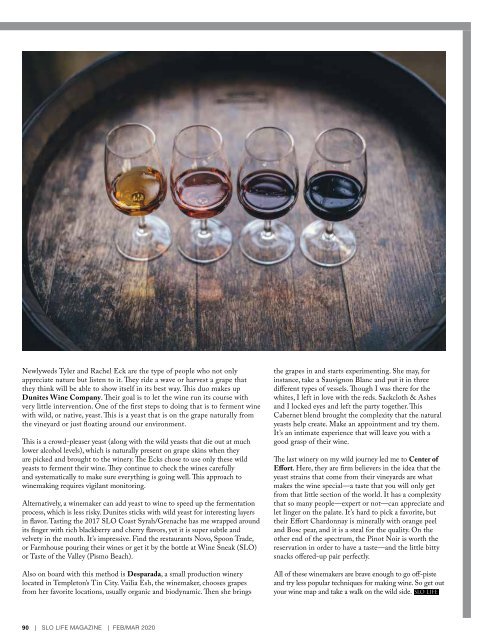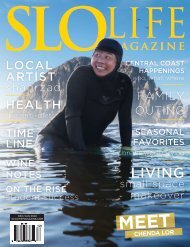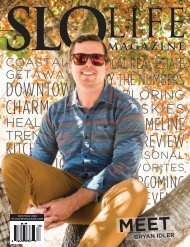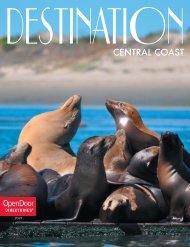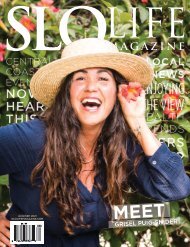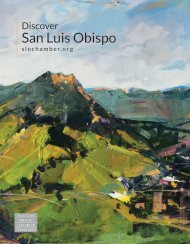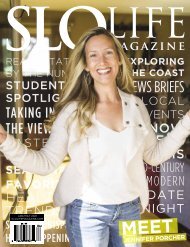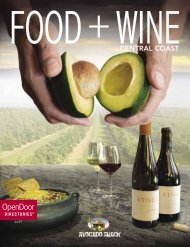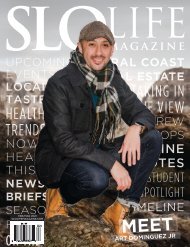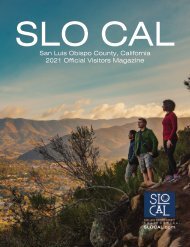SLO LIFE FebMar 2020
You also want an ePaper? Increase the reach of your titles
YUMPU automatically turns print PDFs into web optimized ePapers that Google loves.
Newlyweds Tyler and Rachel Eck are the type of people who not only<br />
appreciate nature but listen to it. They ride a wave or harvest a grape that<br />
they think will be able to show itself in its best way. This duo makes up<br />
Dunites Wine Company. Their goal is to let the wine run its course with<br />
very little intervention. One of the first steps to doing that is to ferment wine<br />
with wild, or native, yeast. This is a yeast that is on the grape naturally from<br />
the vineyard or just floating around our environment.<br />
This is a crowd-pleaser yeast (along with the wild yeasts that die out at much<br />
lower alcohol levels), which is naturally present on grape skins when they<br />
are picked and brought to the winery. The Ecks chose to use only these wild<br />
yeasts to ferment their wine. They continue to check the wines carefully<br />
and systematically to make sure everything is going well. This approach to<br />
winemaking requires vigilant monitoring.<br />
Alternatively, a winemaker can add yeast to wine to speed up the fermentation<br />
process, which is less risky. Dunites sticks with wild yeast for interesting layers<br />
in flavor. Tasting the 2017 <strong>SLO</strong> Coast Syrah/Grenache has me wrapped around<br />
its finger with rich blackberry and cherry flavors, yet it is super subtle and<br />
velvety in the mouth. It’s impressive. Find the restaurants Novo, Spoon Trade,<br />
or Farmhouse pouring their wines or get it by the bottle at Wine Sneak (<strong>SLO</strong>)<br />
or Taste of the Valley (Pismo Beach).<br />
Also on board with this method is Desparada, a small production winery<br />
located in Templeton’s Tin City. Vailia Esh, the winemaker, chooses grapes<br />
from her favorite locations, usually organic and biodynamic. Then she brings<br />
the grapes in and starts experimenting. She may, for<br />
instance, take a Sauvignon Blanc and put it in three<br />
different types of vessels. Though I was there for the<br />
whites, I left in love with the reds. Sackcloth & Ashes<br />
and I locked eyes and left the party together. This<br />
Cabernet blend brought the complexity that the natural<br />
yeasts help create. Make an appointment and try them.<br />
It’s an intimate experience that will leave you with a<br />
good grasp of their wine.<br />
The last winery on my wild journey led me to Center of<br />
Effort. Here, they are firm believers in the idea that the<br />
yeast strains that come from their vineyards are what<br />
makes the wine special—a taste that you will only get<br />
from that little section of the world. It has a complexity<br />
that so many people—expert or not—can appreciate and<br />
let linger on the palate. It’s hard to pick a favorite, but<br />
their Effort Chardonnay is minerally with orange peel<br />
and Bosc pear, and it is a steal for the quality. On the<br />
other end of the spectrum, the Pinot Noir is worth the<br />
reservation in order to have a taste—and the little bitty<br />
snacks offered-up pair perfectly.<br />
All of these winemakers are brave enough to go off-piste<br />
and try less popular techniques for making wine. So get out<br />
your wine map and take a walk on the wild side. <strong>SLO</strong> <strong>LIFE</strong><br />
90 | <strong>SLO</strong> <strong>LIFE</strong> MAGAZINE | FEB/MAR <strong>2020</strong>


